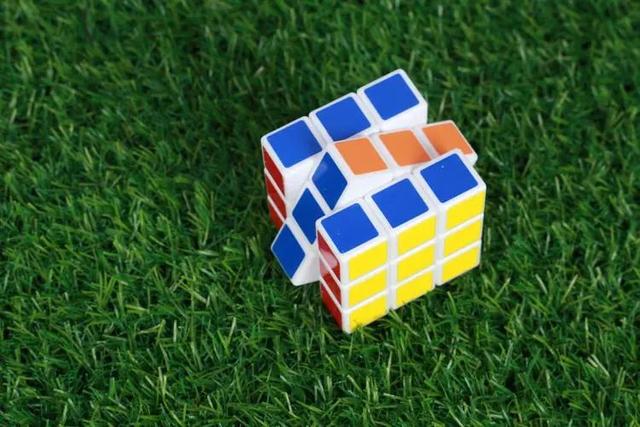Using the kociemba module can quickly get the reduction steps of the third-order Rubik’s Cube, for example:

U = 'Red Green Yellow White Red White White Blue White'
R = 'redbluegreengreengreenblueyellowredred'
F = 'Green Orange Green Yellow White Red Blue Orange Red'
D = 'Orange Yellow Green Red Orange Blue Orange Yellow Yellow'
L = 'white orange orange green blue red white white yellow'
B = 'Orange White Blue Yellow Yellow Orange Blue Green Blue'
cubdict = {U[4]: 'U', R[4]: 'R', F[4]: 'F', D[4]: 'D', L[4]: 'L', B[ 4]: 'B'}
UC = ''
for s in [U, R, F, D, L, B]:
for i in range(9):
UC = UC + cubdict[s[i]]
print(UC)
print(kc.solve(UC))
Designate the side facing you as Front (F), the opposite side as Back (B), the left side as Left (L), the right side as Right (R), the upper side as Up (U), and the lower side as Down ( D), write the colors of the 6 sides of the Rubik’s Cube into U R F D L B respectively, and finally print out all the steps to restore the Rubik’s Cube, follow the steps to restore it.
However, if you have to enter the color yourself every time, you will appear to be relatively low, so you can use the image processing function of opencv to automatically recognize the color of the Rubik’s Cube, for example:
import kociemba as kc
import os
import cv2
import numpy as np
from copy import deepcopy
import math
def imgcheck(frame_raw):
hsv_table = [[[0, 10], [43, 255], [46, 255], 'red'],
[[156, 180], [43, 255], [46, 255], 'red'],
[[11, 20], [43, 255], [46, 255], 'orange'],
[[20, 34], [43, 255], [46, 255], 'yellow'],
[[35, 80], [43, 255], [46, 255], 'green'],
[[80, 99], [43, 255], [46, 255], 'green'],
[[100, 124], [43, 255], [46, 255], 'blue'],
[[125, 155], [43, 255], [46, 255], 'purple'],
[[0, 180], [0, 30], [166, 255], 'white'],
[[0, 180], [0, 43], [46, 166], 'gray'],
[[0, 180], [0, 255], [0, 46], 'black']]
cube_list = []
frame = frame_raw. copy()
index = 0
center = []
candidates = []
hsv = cv2.cvtColor(frame, cv2.COLOR_BGR2HSV)
for process_ind in range(2):
hsv = cv2.cvtColor(frame, cv2.COLOR_BGR2HSV)
#cv2. imshow("image", hsv)
#cv2. waitKey(0)
gray = cv2.cvtColor(frame, cv2.COLOR_BGR2GRAY)
blurred = cv2.GaussianBlur(gray, (3, 3), 0)
canny = cv2.Canny(blurred, 20, 40)
#cv2. imshow("image", canny)
#cv2. waitKey(0)
if process_ind == 0:
kernel = np.ones((3, 3), np.uint8)
dilated = cv2.dilate(canny, kernel, iterations=12)
else:
kernel = np.ones((6, 6), np.uint8)
dilated = cv2.dilate(canny, kernel, iterations=3)
if process_ind == 1 or process_ind == 0:
cv2.imshow("image", dilated)
cv2.waitKey(0)
(contours, hierarchy) = cv2.findContours(dilated.copy(), cv2.RETR_TREE, cv2.CHAIN_APPROX_SIMPLE)
hierarchy = hierarchy[0]
pre_cX = 0
pre_cY = 0
area_arr = []
for component in zip(contours, hierarchy):
contour = component[0]
peri = cv2.arcLength(contour, True)
approx = cv2.approxPolyDP(contour, 0.1 * peri, True)
area = cv2. contourArea(contour)
corners = len(approx)
# compute the center of the contour
M = cv2.moments(contour)
if M["m00"]:
cX = int(M["m10"] / M["m00"])
cY = int(M["m01"] / M["m00"])
else:
cX = None
cY = None
if cX is not None:
if process_ind == 0:
tmp = {'area': area, 'contour': contour}
area_arr.append(tmp)
elif 60000 > area > 1000:
tmp = {'index': index, 'cx': cX, 'cy': cY, 'contour': contour}
center.append(tmp)
index += 1
if process_ind == 0:
area_arr.sort(key=lambda k: (k.get('area', 0)), reverse=True)
mx,my,mw,mh = cv2.boundingRect(area_arr[0].get('contour'))
cv2.rectangle(frame, (mx,my), (mx + mw, my + mh), (0, 255, 0), 2)
#cv2. imshow("image", frame)
#cv2. waitKey(0)
frame = frame[my-5:my + mh + 5, mx-5:mx + mw + 5]
#cv2. imshow("image", frame)
#cv2. waitKey(0)
frame = cv2.resize(frame, (320, 320))
#if index < 9:
# return
print(str(index))
'''
center.sort(key=lambda k: (k.get('cx', 0)))
center.sort(key=lambda k: (k.get('cy', 0)))
'''
center.sort(key=lambda k: (k.get('cy', 0)))
row1 = center[0:3]
row1.sort(key=lambda k: (k.get('cx', 0)))
row2 = center[3:6]
row2.sort(key=lambda k: (k.get('cx', 0)))
row3 = center[6:9]
row3.sort(key=lambda k: (k.get('cx', 0)))
center. clear()
center = row1 + row2 + row3
for component in center:
candidates.append(component.get('contour'))
x,y,w,h = cv2.boundingRect(component.get('contour'))
if abs(w - h) < 10:
cv2.rectangle(frame, (x, y), (x + w, y + h), (0, 255, 0), 2)
#cv2. imshow("image", frame)
#cv2. waitKey(0)
h_ = 0
s_ = 0
v_ = 0
ss = w * h
for i in range(w):
for j in range(h):
h_ = h_ + hsv[y+j][x+i][0]
s_ = s_ + hsv[y+j][x+i][1]
v_ = v_ + hsv[y+j][x+i][2]
h_ = h_/ss
s_ = s_ / ss
v_ = v_ / ss
print(str(h_) + ',' + str(s_) + ',' + str(v_))
for k in hsv_table:
if k[0][0] < h_ < k[0][1] and k[1][0] < s_ < k[1][1] and k[2][0] < v_ < k[2] ][1]:
# print(k[3])
cube_list.append(k[3])
break
print(str(len(cube_list)))
#if len(cube_list) == 9:
print(cube_list)
#cv2. drawContours(frame, candidates, -1, (0, 0, 255), 3)
cv2.imshow("image", frame)
cv2.waitKey(0)
if __name__ == "__main__":
webcam = cv2. VideoCapture(0)
if not webcam.isOpened():
print("can't open the camera!!!")
while True:
ret, frame = webcam. read()
rec_w = 200
rec_h = 200
rec_y = int((frame.shape[0] - rec_h)/2)
rec_x = int((frame.shape[1] - rec_w) / 2)
cv2.rectangle(frame, (rec_x, rec_y), (rec_x + rec_w, rec_y + rec_h), (0, 255, 0), 2)
imgcheck(frame)
cv2.imshow("video", frame)
if cv2.waitKey(1) & 0xFF == ord('q'):
break
webcam. release()
cv2.destroyAllWindows()
The range of each color of hsv_table may need to be debugged according to the actual situation.